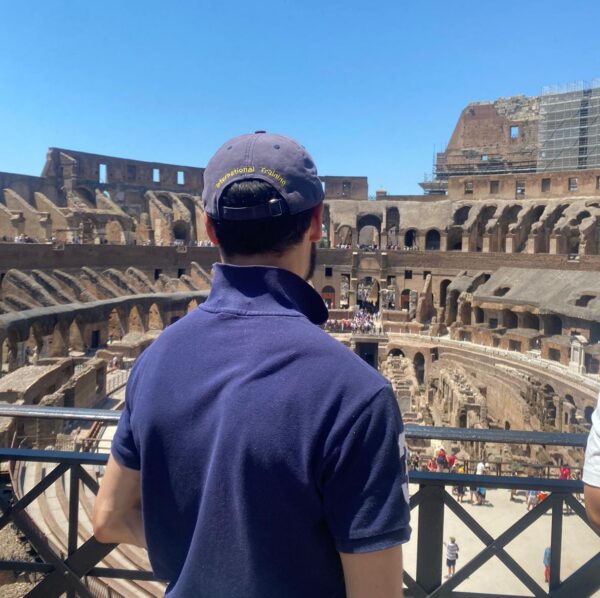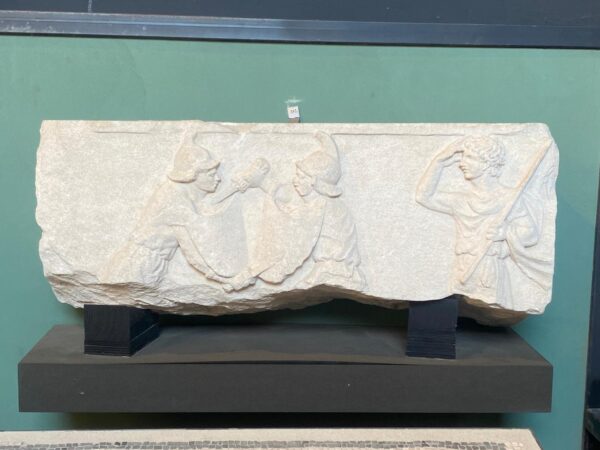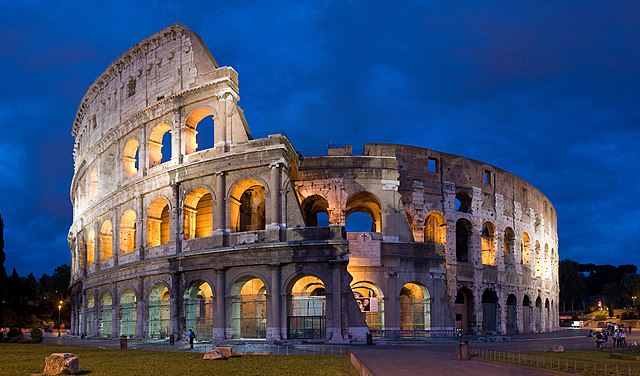Perhaps the most famous arena in the world, the Coliseum was host to the largest combat spectacle in the Roman Empire. Gladiatorial combat harkens back to the days of funeral games but was banned by Christian emperors for its glorification of death and eventually ceased following the sack of Rome by Alaric and his Gothic army. Our editor writes from the ruins of the august arena.
The victorious troops, led by a general, would walk along the Via Sacra through the Arch of Septimus Severus and up to the Capitoline Hill in Rome, where they would sacrifice to the god Jupiter. Along the Via Sacra, while the victorious army marched and dragged their captives and spoils of war after them, the soldiers would be greeted by cheering crowds. Some of the captives would end up being gladiators, facing another cheering mass, gathered to see the slaves engage in mortal combat. The most significant arena for such combat was built before the Arch of Septimus Severus and stands within walking distance from the Via Sacra and saw triumphant marches pass beneath its walls.
THE ARENA
Finished in 80 AD, the Colosseum is sometimes known as the Amphitheatre of Flavian, as it was during the reign of the three emperors of the Flavian dynasty: Vespasian, Titus, and Domitian. The construction of the arena began in 71 AD, financed by the spoils of the Jewish war of 70. In 80 AD it was solemnly inaugurated by Titus. It would not have been known as the Amphitheatre of Flavian, however, as there are no records to suggest it, but rather it was known as Amphitheatrum magnum (the big amphitheatre) or Ceasareum. It was not until the middle ages that it was given the name Colysaeum, most likely due to its near proximity to the Colossus erected by the emperor Nero.

THE PEOPLE
It was free to enter the arena, with members of various social classes entering through 76 arches with numbers carved and marked in red. Spectators would follow paths indicated on the inner arches, which were also marked on the tickets which were given to the heads of each family. The seating was hierarchical, and the seats were arranged so that the best seats were reserved for senators. These places would be closest to the arena. The rear sector was for knights (equites) and two sectors seated progressively lower classes. The worst seats in the arena were inconvenient to reach and had a poor overview of the action taking place in the amphitheatre, and were situated in the colonnaded portico at the top of the cavea (the tiered semicircular seating space of an ancient theatre) with wooden seats. The best view of all was naturally kept for the emperor at the imperial box, which was placed at the south entrance.
THE GLADIATORS
The gladiators were often prisoners of war, slaves or criminals condemned to death. On rare occasions, free men chose to fight in gladiatorial combat to show their strength and courage, but this was only for brief periods of the history of the dreaded games. Fighters would be assembled in groups and trained by lanista, who was chosen by the editor. In the case of Rome and the Colosseum, the editor was the emperor. The armour worn by the gladiators during the republican period would be inspired by enemy peoples. It was only during the Augustan age that gladiators would be grouped into different types, defined by their equipment, such as the thrax (armed with a small rectangular, square or circular shield called a parmula (about 60 x 65 cm) and a very short sword with a slightly curved blade called a sica), the retiarius (fighting with equipment styled on that of a fisherman), and the provocator (wearing a distinctive partial breastplate and armed with a short sword with a straight blade). The offensive and defensive weapons used would be arranged so as to ensure a balanced fight for maximum value for the spectators.

The fights would typically include pairs of gladiators chosen on the basis of their equipment. Gladiators could ask for mercy, at which time the editor (in this case the emperor) would grant mercy or allow the defeated combatant to be killed if he had not yet fallen by the sword of his opponent. Gladiatorial combat was hugely popular and attracted thousands of spectators on frequent occasions. The frenzied crowds relished in the games and as mentioned earlier they came from all classes. Animals would be thrown in to compete against men, where there would at times be as many as 300 bears facing hundreds of men.
The gladiatorial games are a far cry from modern combat sports. But they nevertheless play a part in the history of our sport in the Western world. Starting with the Greeks who used boxing, wrestling, and the mixed martial art of pankration as a form of simulating combat, fights would at times end with the death of one of the fighters. It is easy to see how the next step would be to arm the combatants to simulate war even more accurately, but the spectacle seems to be a distinctively Roman phenomenon. We still hear of fighters being referred to as gladiators and fighters referring to themselves as warriors. The human spirit has always desired to see who is the better, stronger, faster, more disciplined man or woman. With modern MMA, there is a way of providing for this instinct without the brutal number of casualties that the gladiatorial combats brought.
Lyssna på det senaste avsnittet av Fighterpodden!

Kommentarer